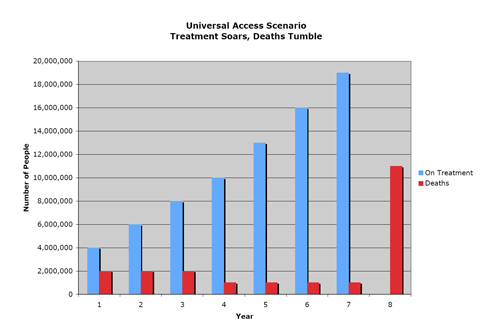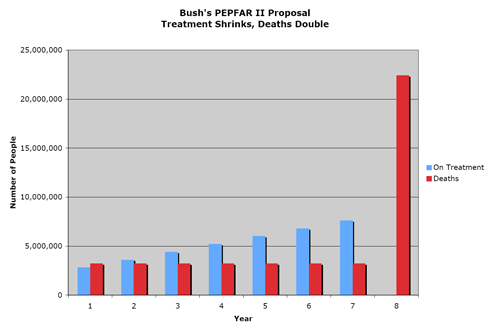Economists, the Trump Tariffs, and Alternatives
One should not jump from the condemnation of Trump’s tariffs by economists (and others) to an acceptance of free trade as a key to economic progress.
The United States, the rest of the G-8 group of industrialized nations, and the U.N. General Assembly have all committed to achieving virtually universal access to AIDS treatment worldwide by 2010. This means providing antiretroviral therapy to 9.8 million people by that date. To do so, and to maintain universal access for those newly needing treatment each year thereafter, will require nearly tripling the number of new patients entering treatment annually: from 700,000 to 2 million. Meeting this goal will, in turn, require major investments in health care capacity, especially in Africa.
In contrast to this bold but achievable goal, President Bush has announced a misleading plan to ?double? spending on the President's Emergency Plan for AIDS Relief (PEPFAR): from $15 billion in total from 2004-2008 to $30 billion from 2009-2013. Bush's simple math tells a complex lie. Not only does the president's new plan fail to double spending compared to the first five years of PEPFAR. It also fails to meet the president's stated promise to double the number of people on treatment, and comes nowhere near the United States' fair contribution to the global sum necessary to make the commitment to universal access a reality. The only number that truly doubles under Bush's PEPFAR II proposal is the number of people who will die of AIDS from 2007 through 2013?from a tragic-enough 11 million under the internationally recognized universal access scenario, to an unforgivable 22.4 million under the Bush plan.
For example, far from doubling U.S. spending on AIDS prevention and treatment abroad, Bush's PEPFAR II offer of $30 billion over five years represents only about a 59% increase over the United States' actual international AIDS spending over the five years of PEPFAR I, which have come to about $18.85 billion. In fact, his plan flatlines the current U.S. spending level: Congressional committees have proposed $5.95 billion for international AIDS programming for fiscal year '08 (Senate appropriations may bring the total even higher), and Bush's PEPFAR II proposal keeps annual spending at $6 billion a year from 2009 to 2013. Likewise, the PEPFAR II proposal can hardly be said to double the number of people on treatment. True, Bush's press release talked about more than doubling the current number on treatment, 1.1 million, to 2.5 million by 2013, but Bush's original promise for PEPFAR I, which still has a year and a half to go, was that 2 million people would receive treatment by the end of 2008. Thus, Bush's bold plan for 2009-2013 is to add a paltry half million to that number!
Here's how to calculate the additional number of people with AIDS who will die prematurely under Bush's new proposal, in comparison with the promise of universal access.

As of the end of 2006, two million people with AIDS in low- and middle-income countries were receiving antiretroviral treatment. Typically, patients need to begin treatment eight to ten years after they first become infected with HIV. So we can estimate the number who will need to enter treatment annually from 2007 to 2013 based on estimates of how many people a year became infected in the late 1990s: four to five million. (I'll use the more conservative four million figure.)
To compare Bush's proposal with universal access, we need to spell that scenario out. Pragmatically, universal access will not mean 100% coverage, but rather 75% to 80% coverage because of the stark realities of identifying people with late-stage AIDS and difficulties convincing people to accept treatment. A reasonable scenario for building up to universal access by 2013 (matching the final year of PEPFAR II) would entail initiating treatment for 50% of the people newly needing it each year from 2007 to 2010 and for 75% beginning in 2011. This would put a cumulative total of 19 million people into treatment as of 2013.

Assuming that premature death rates are close to 100% for those who do not receive treatment, about 11 million people with AIDS in low- and middle-income countries would die over the seven-year period under this scenario.
In contrast, I estimate that under Bush's plan for PEPFAR II, about 22.4 million people with AIDS in these countries will die over the same period.
Under the president's PEPFAR II proposal, with its minuscule new investments, the number of people being placed on treatment will likely grow at a snail's pace: from the current rate of 700,000 per year to 800,000 per year. Moreover, Bush's low-ball commitment will depress global expectations; other donors and developing countries will probably match Bush's half-measures. Initiating treatment for only 800,000 new patients a year would put a cumulative total of 7.6 million into treatment as of 2013. Thus, about 11.4 more people with AIDS can be expected to die prematurely over the 2007-2013 period under Bush's plan than under a pragmatic universal access scenario.
According to this real math, the death toll under the Bush plan doubles?and each of those extra 11.4 million deaths is not only regrettable, but preventable.
Obviously, these are oversimplified scenarios. The U.N. HIV/AIDS Program (UNAIDS) and the World Health Organization (WHO) need to provide more accurate and sophisticated analyses. For instance, these calculations do not take into account the fact that some people on treatment will die nonetheless, either because they start treatment too late or because of eventual treatment failure. Likewise, they do not take into account slow uptake in testing, the impact of treatment on HIV transmission, or the eventual impact of stronger prevention campaigns.
At the same time, these scenarios do not take into account some factors that could significantly boost estimates of the number of people needing treatment, including a growing scientific consensus that treatment should start earlier in the course of the disease, before a critical cell count falls to the currently used benchmark. This change alone could require a one-time boost in estimates of treatment need from the current estimates of 7.1 million now and 11 million in 2010, to 10 million now and nearly 16 million in 2010, according to a June 2007 UNAIDS report. Likewise, future treatment may prove even more effective in suppressing replication of the virus, thus extending patients' lives even longer.
Universal access faces real challenges. People need to know their status and they need to know it earlier so that treatment can be started before the disease is too advanced to respond. Developing countries need to make major investments in expanding human resources for health and in strengthening health systems. Africa alone needs over a million new doctors, nurses, and midwives, and it needs a new cadre of paid community health workers as well. Treatment rollout must extend from the easier-to-reach urban areas to harder-to-reach rural areas. In addition, health facilities, health sector management, and procurement and distribution systems all have to be improved. Sustaining treatment initiatives will require addressing the high cost of second-line therapies, which already threaten budgets in Brazil, Thailand, and other countries that succeeded early in providing relatively wide access to treatment.
Beyond these treatment-related challenges, AIDS-afflicted countries need to implement comprehensive structural and behavioral prevention programs that really work, and those programs have to expand in scope from the 20% coverage typical today to 100% coverage.
Unfortunately, instead of having the financial and technical resources and the political commitment to focus on these real problems?the true dilemmas of universal access?the people battling AIDS on the ground and their allies have to waste time responding to misleading pronouncements from politicians like George Bush who try to trick the press into thinking that twice as many deaths represents a doubling of the U.S. global AIDS effort. According to UNAIDS, AIDS funding needs will rise from $22 billion in 2008 to $30 billion by 2010, and, according to WHO, massive new investments are needed in health systems and in health personnel. To really contribute to universal access, the United States must pay its true one-third fair share (based on the size of the U.S. economy as a share of the global economy) through PEPFAR II, its other bilateral AIDS programs, and the Global Fund to Fight AIDS, Tuberculosis and Malaria.
Activists have to redouble our efforts to champion universal access and to condemn lies that undermine its achievement. Instead of acquiescing to Bush's let-them-die proposal, we need a five-year PEPFAR II that truly doubles global AIDS spending by the United States to over $50 billion and that commits to providing prevention, care, and treatment support for one-third of those in need.
In particular, we need presidential candidates and congressional leaders who will not blink at an $8 billion, then $10 billion, then $12 billion a year price tag, roughly what the United States spends in one week on the military. Rather than being satisfied that Bush's simple math and condition-ridden PEPFAR II proposal solves the global AIDS pandemic, U.S. leaders should step up to the plate and work with developing country partners to fund a sustainable and robust response to the world's long-lasting and worst health crisis.